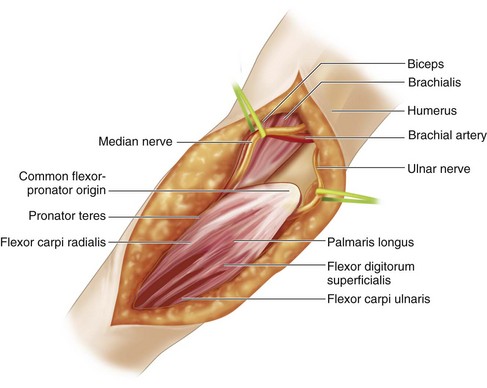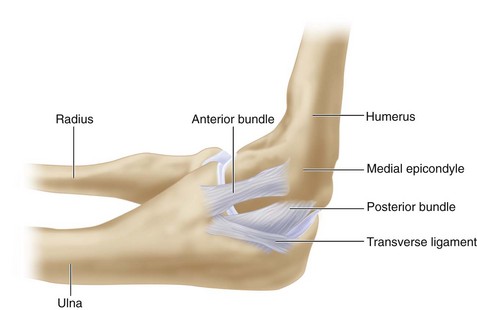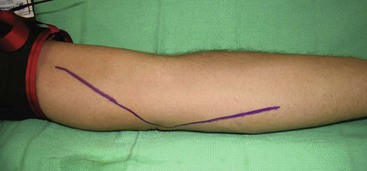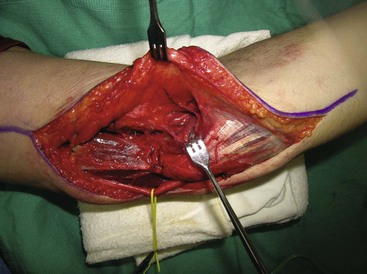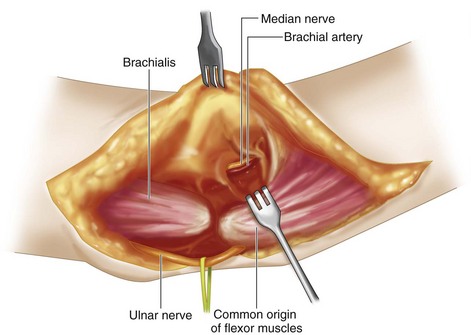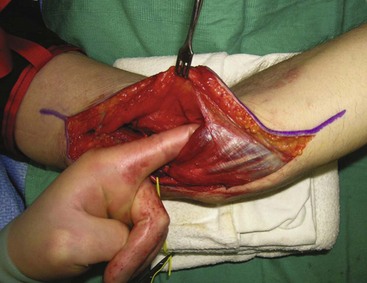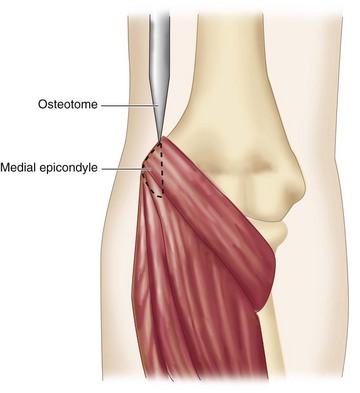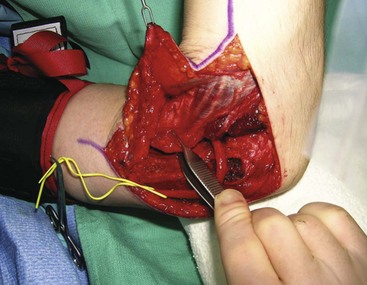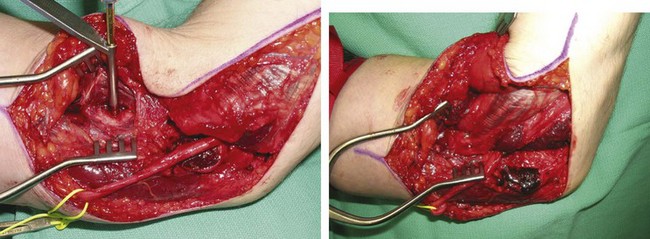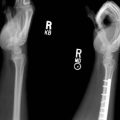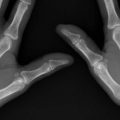Procedure 21 Steindler Flexorplasty
Indications
 Late presentation of upper trunk brachial plexus palsy (C5-C6; C5-C6-C7) without recovery of elbow flexion.
Late presentation of upper trunk brachial plexus palsy (C5-C6; C5-C6-C7) without recovery of elbow flexion.
Examination/Imaging
Clinical Examination
 The patients should have adequate strength in the flexor pronator mass, especially the wrist flexors [flexor carpi radialis (FCR) and flexor carpi ulnaris (FCU)]. This can be assessed by asking the patient to flex the wrist against resistance.
The patients should have adequate strength in the flexor pronator mass, especially the wrist flexors [flexor carpi radialis (FCR) and flexor carpi ulnaris (FCU)]. This can be assessed by asking the patient to flex the wrist against resistance.
 The patient should have good wrist extension to counteract the possible development of a wrist flexion contracture.
The patient should have good wrist extension to counteract the possible development of a wrist flexion contracture.
 The patients should have adequate passive flexion of the elbow. If passive flexion of the elbow is limited owing to a tight triceps, then triceps lengthening may be necessary to increase passive range of motion.
The patients should have adequate passive flexion of the elbow. If passive flexion of the elbow is limited owing to a tight triceps, then triceps lengthening may be necessary to increase passive range of motion.
Surgical Anatomy
 The common flexor-pronator muscles originate from the medial epicondyle. The following muscles are elevated during this procedure: pronator teres, FCR, palmaris longus, FCU, and flexor digitorum superficialis (Fig. 21-1). The flexor digitorum profundus is left in situ (see Fig. 21-1).
The common flexor-pronator muscles originate from the medial epicondyle. The following muscles are elevated during this procedure: pronator teres, FCR, palmaris longus, FCU, and flexor digitorum superficialis (Fig. 21-1). The flexor digitorum profundus is left in situ (see Fig. 21-1).
 The ulnar nerve must be protected during elevation of the flexor-pronator mass. It may be transposed anteriorly in the submuscular plane.
The ulnar nerve must be protected during elevation of the flexor-pronator mass. It may be transposed anteriorly in the submuscular plane.
 The medial (ulnar) collateral ligament of the elbow should be protected during elevation of the flexor-pronator mass. It originates at the posterior distal aspect of the medial epicondyle and inserts into the base of the coronoid process of ulna. It is composed of three bands: anterior, posterior, and transverse (Fig. 21-2).
The medial (ulnar) collateral ligament of the elbow should be protected during elevation of the flexor-pronator mass. It originates at the posterior distal aspect of the medial epicondyle and inserts into the base of the coronoid process of ulna. It is composed of three bands: anterior, posterior, and transverse (Fig. 21-2).
Exposures
 A 10-cm longitudinal curvilinear incision centered over the medial epicondyle is made (Fig. 21-3).
A 10-cm longitudinal curvilinear incision centered over the medial epicondyle is made (Fig. 21-3).
 A skin flap is elevated while protecting the medial antebrachial cutaneous nerve. After elevation of the skin flap, one will see the flexor-pronator mass attaching to the medial epicondyle (Fig. 21-4).
A skin flap is elevated while protecting the medial antebrachial cutaneous nerve. After elevation of the skin flap, one will see the flexor-pronator mass attaching to the medial epicondyle (Fig. 21-4).
 The ulnar nerve is protected, and a vessel loop is placed around the nerve for identification and gentle traction (Fig. 21-5).
The ulnar nerve is protected, and a vessel loop is placed around the nerve for identification and gentle traction (Fig. 21-5).
 Lateral to the flexor-pronator mass, the brachial artery and median nerve are seen entering the arch over the superficialis muscles (Fig. 21-6).
Lateral to the flexor-pronator mass, the brachial artery and median nerve are seen entering the arch over the superficialis muscles (Fig. 21-6).
Procedure
Step 1
 The index finger is placed under the flexor-pronator mass to develop an interval plane between the median nerve and the entire flexor-pronator mass (Fig. 21-7). The ulnar head of FCU is dissected from the ulna.
The index finger is placed under the flexor-pronator mass to develop an interval plane between the median nerve and the entire flexor-pronator mass (Fig. 21-7). The ulnar head of FCU is dissected from the ulna.
Step 2
Step 4
Step 5
 The medial epicondyle can be provisionally fixed to the trough created in the distal humerus and secured using a towel clip.
The medial epicondyle can be provisionally fixed to the trough created in the distal humerus and secured using a towel clip.
 Secure fixation to the humerus is achieved by passing a 3.5-mm cortical screw over a washer through the medial epicondyle. A 2.5-mm drill bit and a 3.5-mm tap are used for this purpose (Fig. 21-11).
Secure fixation to the humerus is achieved by passing a 3.5-mm cortical screw over a washer through the medial epicondyle. A 2.5-mm drill bit and a 3.5-mm tap are used for this purpose (Fig. 21-11).
 After securing the bone, the ulnar nerve is then transposed anteriorly under the flexor-pronator mass. The muscle is then closed over the native medial epicondyle using 2-0 Vicryl sutures.
After securing the bone, the ulnar nerve is then transposed anteriorly under the flexor-pronator mass. The muscle is then closed over the native medial epicondyle using 2-0 Vicryl sutures.
Postoperative Care and Expected Outcomes
 The elbow is splinted at 90 degrees for 6 weeks to allow fusion of the osteotomized medial epicondyle to the humerus. After 2 weeks, the sutures are removed, and a thermoplastic splint is made to immobilize the elbow at 90 degrees of flexion for another 4 weeks. During the first 6 weeks, the patient should move the fingers to prevent contracture. After 6 weeks, the patient is started on gentle gravity-assisted extension of the elbow while initiating elbow flexion exercises. After 12 weeks, resisted flexion is started.
The elbow is splinted at 90 degrees for 6 weeks to allow fusion of the osteotomized medial epicondyle to the humerus. After 2 weeks, the sutures are removed, and a thermoplastic splint is made to immobilize the elbow at 90 degrees of flexion for another 4 weeks. During the first 6 weeks, the patient should move the fingers to prevent contracture. After 6 weeks, the patient is started on gentle gravity-assisted extension of the elbow while initiating elbow flexion exercises. After 12 weeks, resisted flexion is started.
 It is not advisable for the patient to stretch to achieve full extension of the elbow because the purpose of this operation is to achieve sufficient elbow flexion, which is more beneficial to the patients. The patient can be expected to achieve an arc of flexion of 30 to 100 degrees that will reach to the mouth.
It is not advisable for the patient to stretch to achieve full extension of the elbow because the purpose of this operation is to achieve sufficient elbow flexion, which is more beneficial to the patients. The patient can be expected to achieve an arc of flexion of 30 to 100 degrees that will reach to the mouth.
Chen WS. Restoration of elbow flexion by modified Steindler flexorplasty. Int Orthop. 2000;24:43-46.
Dutton RO, Dawson EG. Elbow flexorplasty: an analysis of long-term results. J Bone Joint Surg [Am]. 1981;63:1064-1069.
Goldfarb CA, Burke MS, Manske PR, et al. The Steindler flexorplasty for the arthrogrypotic elbow. J Hand Surg [Am]. 2004;29:462-469.
Liu TK, Yang RS, Sun JS. Long-term results of the Steindler flexorplasty. Clin Orthop Relat Res. 1993;296:104-108.
Monreal R. Steindler flexorplasty to restore elbow flexion in C5-C6-C7 brachial plexus palsy type. J Brachial Plex Peripher Nerve Inj. 2007;2:15.



